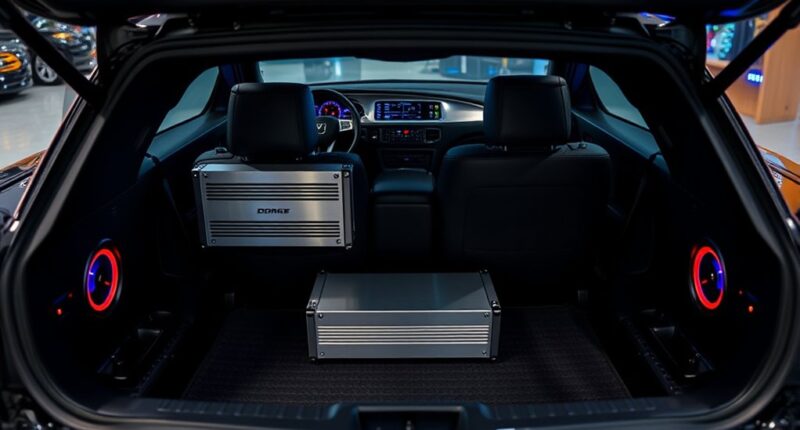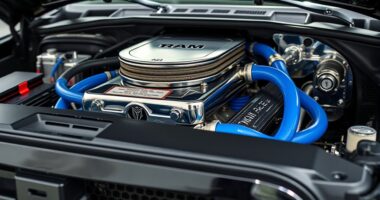Installing a sound system in your Dodge Charger involves selecting the right speakers, amplifiers, and subwoofers to match your needs and budget. You’ll need tools to remove panels, upgrade factory components, and guarantee proper wiring for sound clarity. Upgrading factory systems or adding new hardware can boost audio quality markedly. With proper planning and installation techniques, you can create a powerful, clear sound experience—keep going to discover how to achieve the best setup for your Charger.
Key Takeaways
- Choose appropriate factory upgrade options like Alpine, Beats, or Harman Kardon for better sound quality.
- Properly remove panels and access wiring for seamless speaker and subwoofer installation.
- Use compatible harness adapters and line output converters to integrate aftermarket amplifiers with factory systems.
- Select suitable speakers and shallow-mount subwoofers based on space and desired sound performance.
- Troubleshoot wiring, fuses, and settings to resolve common installation issues and ensure optimal audio performance.
Overview of Dodge Charger Sound System Options

The Dodge Charger offers a range of sound system options to suit different audio preferences and budgets. Most trims come with a standard 6-speaker system, perfect for basic listening. If you want clearer sound, the mid-tier Alpine system is available. For deeper bass and energetic genres like hip-hop or electronic music, the 10-speaker Beats system is a great choice. The top-tier option is the 19-speaker Harman Kardon system, featuring Logic7 surround sound and a powerful 900W amplifier, all with GreenEdge technology that reduces energy use without sacrificing audio quality. These options allow you to tailor your in-car audio experience, whether you prefer simple tunes or immersive, high-fidelity sound. Upgrading or customizing your system is also common to meet specific preferences. Additionally, exploring eco-friendly technologies in sound systems can help reduce energy consumption while maintaining excellent audio performance. Incorporating energy-efficient audio components can further enhance sustainability without compromising sound quality. Ensuring your sound system utilizes sustainable energy practices can contribute to a greener driving experience and aligns with broader efforts to implement payment processing innovations that promote efficiency and security in the automotive industry. Integrating smart home device compatibility into your audio system can also provide seamless control and added convenience while driving.
Selecting the Right Speakers for Your Charger
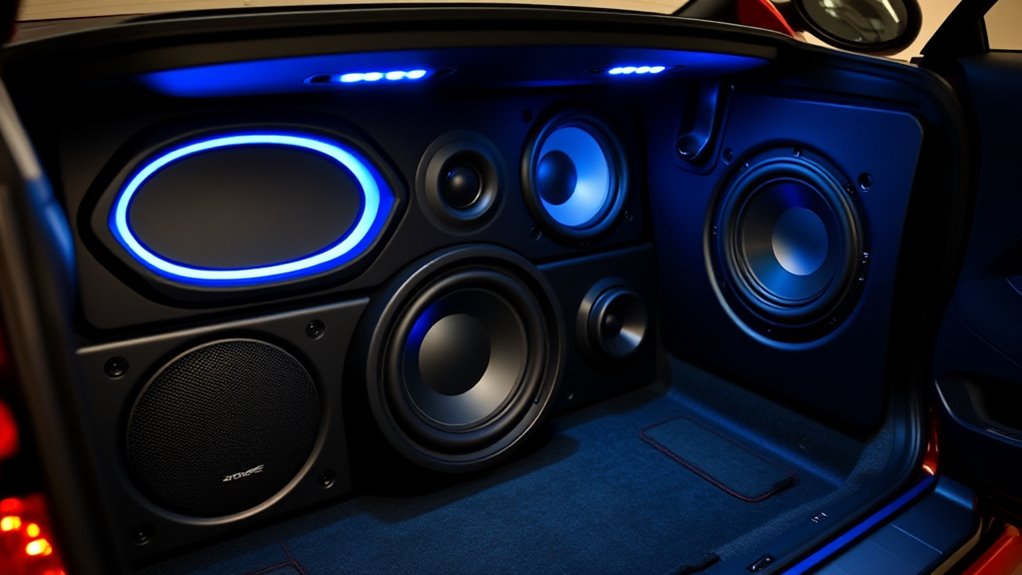
Choosing the right speakers for your Dodge Charger depends on your audio goals and how much you’re willing to invest. For a simple upgrade, 3.5-inch dash speakers fit in factory locations and are common in 6- or 10-speaker systems. If you want better sound, consider 6×9-inch front door speakers or custom pods with dual 6.5-inch setups, especially in models from 2008-2010. Keep in mind, factory systems like Alpine or Harman Kardon may have low-impedance speakers, so check compatibility to avoid volume issues. Coaxial speakers offer straightforward upgrades, while component sets improve sound staging but require more work. External amps are highly recommended to maximize sound quality, especially with aftermarket speakers, and always consider if factory features like steering wheel controls will need adapters. Environmental Considerations are important to ensure your installation respects the vehicle’s existing systems and the environment. Additionally, selecting speakers with appropriate power handling capabilities can prevent damage and optimize performance. Being aware of AI vulnerabilities in electronic components can help you choose more reliable and durable hardware for your installation. Moreover, understanding automated systems can assist in integrating your new audio setup seamlessly with the vehicle’s existing electronics. To ensure optimal performance, selecting speakers with durability in automotive environments is crucial, as they must withstand temperature fluctuations and vibrations.
Tools and Materials Needed for a Successful Installation
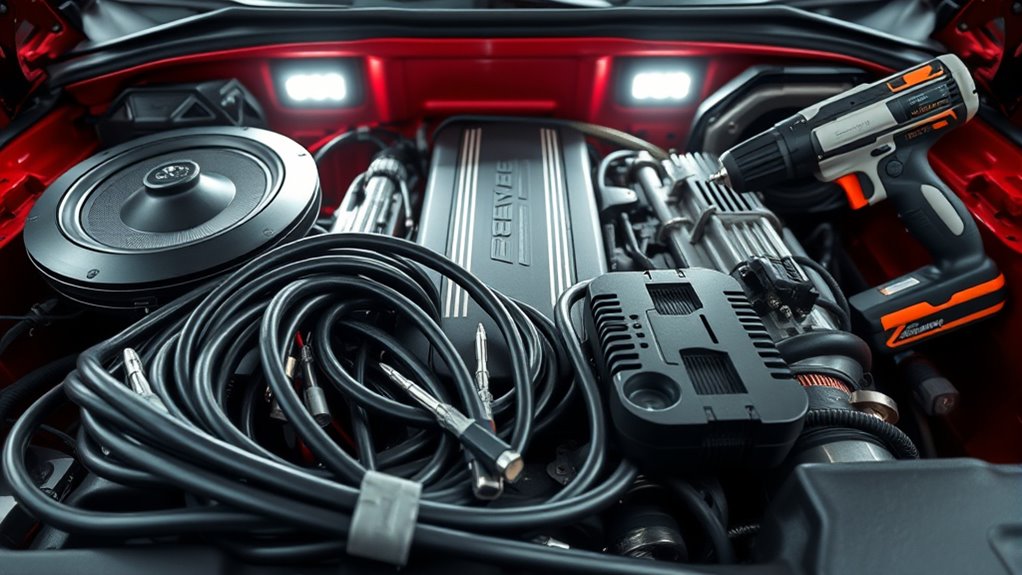
To guarantee a smooth and effective sound system installation in your Dodge Charger, gathering the right tools and materials is essential. You’ll need specific items to ensure proper wiring, secure connections, and safe mounting. Essential tools include a wire cutter/stripper, panel removal tools, a crimping tool, and a utility knife. These help you prepare wires, remove panels, and access tight spaces efficiently. For wiring and signal conversion, use line output converters, a 4-gauge amplifier wiring kit, and harness adapters to maintain factory compatibility. To protect your system and ensure safety, have in-line fuse holders, heat shrink tubing, a multimeter, and cable ties. These materials help organize wiring, prevent shorts, and verify electrical integrity, making your installation safe and professional. Additionally, understanding audio system components can help you select appropriate equipment for optimal sound quality. Ensuring compatibility with home theater audio standards can further improve your setup and overall listening experience. Incorporating soundproofing techniques can also minimize road noise and enhance audio clarity during driving. Moreover, using proper installation practices such as secure mounting and correct wiring routing can significantly increase the longevity and performance of your sound system. Additionally, using remote work principles such as proper organization and planning can streamline your installation process, reducing stress and increasing efficiency.
Removing and Replacing Dash and Door Speakers
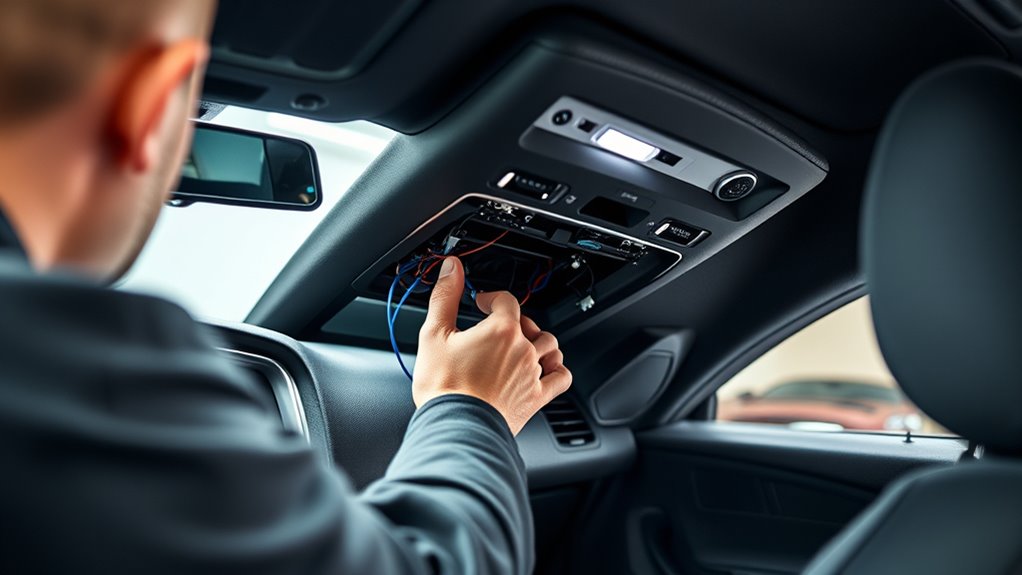
Removing and replacing dash and door speakers in your Dodge Charger requires careful handling to avoid damage and guarantee proper fitment. Start by removing the dash speaker grille with plastic trim tools, gently prying around concealed clips to prevent breakage. Be aware that some grilles hide screws in recesses, which may need door trim removal first. Disconnect wiring harnesses behind the grille carefully. For door speakers, disassemble the panels by removing screws beneath armrests, handle recesses, and lower trim. Depress center pins on trim clips to prevent breakage, and carefully disconnect wiring for power controls or window switches. If present, peel back moisture barriers for access. Factory mounts may involve rivets, so use appropriate tools to detach the speakers without damaging surrounding components. Proper safety precautions should be taken to avoid injury during removal and installation. Additionally, understanding the importance of quality assurance can help ensure the installation process maintains high standards and prevents future issues. Being aware of the exfoliating benefits of glycolic acid can also help you achieve better results in skin care, which can be an important part of vehicle maintenance routines. Ensuring compatibility of new speakers with your vehicle’s audio system specifications is crucial for optimal performance and sound quality.
Upgrading Rear Deck and Subwoofer Components

Upgrading the rear deck and adding a subwoofer to your Dodge Charger can substantially enhance your audio experience. To do this, you’ll need to remove the rear deck trim panel and install new speakers like the Alpine SPE-6090 6×9″ coaxials for improved sound clarity. For seamless wiring, use Metra 72-6514 harness adapters. If you want deeper bass, modify the rear deck lid opening with an air saw or die grinder to fit an 8″ or 10″ subwoofer, such as dual 4-ohm models. Consider custom enclosures designed specifically for your Charger model to optimize space and sound quality. Use high-quality cables like NVX XKIT82 with 8-gauge wiring to power your subwoofer effectively. Proper upgrades result in a richer, more immersive listening experience on the road. Additionally, choosing appropriate subwoofer sizes can significantly impact sound performance and fitment within your vehicle. Incorporating sound system upgrades can further enhance your driving audio experience and ensure optimal performance. Understanding Mazda Tuning concepts can also inspire creative ways to customize your vehicle’s audio and overall entertainment system. It’s also beneficial to consider soundproofing techniques to reduce road noise and improve sound clarity inside your car.
Integrating Amplifiers and Signal Processing Equipment
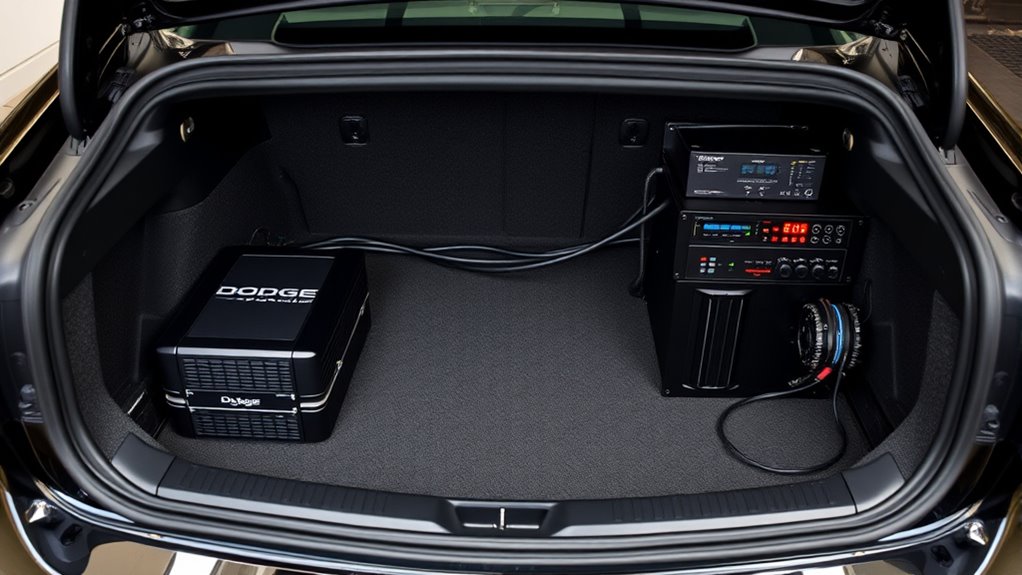
Integrating amplifiers and signal processing equipment into your Dodge Charger enhances sound clarity and power, but it requires careful selection of hardware and proper wiring. You’ll want compatible interfaces like the AmpPRO 4 AP4-CH21 for factory Alpine systems, or PAC’s Advanced Interface (AP4) for data-bus-controlled setups. Plug-and-play T-harnesses simplify wiring, while dip switches allow model-specific adjustments. Use remote turn-on outputs to activate aftermarket amps seamlessly. Low-carb options in components and accessories can help optimize your installation for both performance and efficiency. Additionally, selecting appropriate wiring and connectors is essential to maintain signal integrity and ensure a reliable setup.
Retrofitting Factory Systems for Enhanced Audio Performance

To improve your Dodge Charger’s audio performance, you’ll need to carefully analyze the factory system’s components and wiring setup. Check if your model has factory Alpine, Beats, or Harman Kardon systems, which include rear-deck 6″x9″ speakers and, in higher trims, 8″ subwoofers. Accessing the rear deck subwoofer involves removing the seat bolster with 10mm screws and prying out the panel, which may require bowing it forward to clear the seat belt tether. Be mindful of the subwoofer impedance, often 1-2Ω, to guarantee compatibility with aftermarket replacements. Using speaker-specific mounting brackets from Crutchfield simplifies installation.
- Verify factory wiring and impedance compatibility
- Use line output converters for signal integration
- Choose polypropylene or shallow-mount subwoofers for space
- Opt for plug-and-play harnesses to avoid splicing
Managing Impedance and Compatibility Challenges
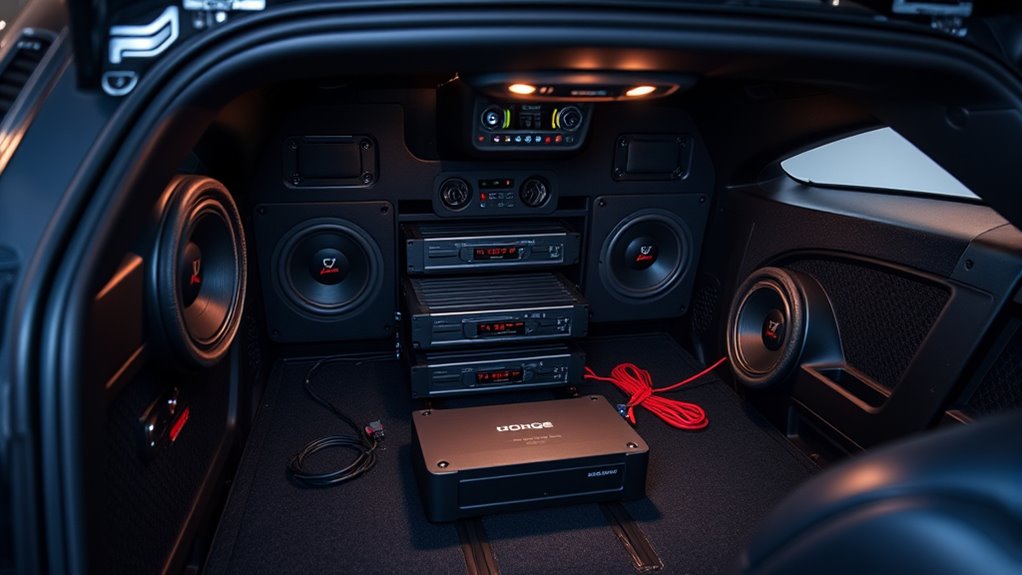
Managing impedance and compatibility challenges is essential when customizing your Dodge Charger’s audio system. Factory speakers, usually 1-2 ohms in OEM systems, maximize power from factory amps but can cause issues when replacing or upgrading components. Using 4-ohm aftermarket speakers without upgrading your amplifier halves power output, reducing volume but improving clarity. Mismatched impedance risks distortion if your amplifier isn’t stable at low loads, so impedance-matching devices or rewiring may be necessary. Factory amplifiers are optimized for low-impedance loads, while aftermarket amps often require 2-4 ohm stability. To prevent damage, consider hybrid setups—keeping OEM subs for bass and pairing them with 4-ohm midrange or tweeters. Proper matching ensures ideal sound quality without risking amplifier or speaker damage.
Cost-Effective Strategies for a High-Quality Sound System
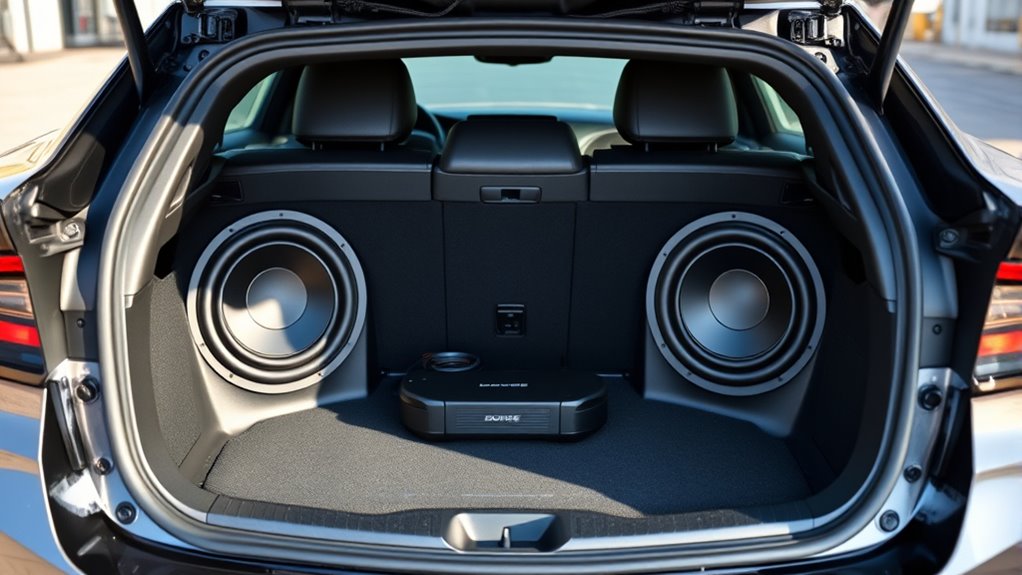
Creating a high-quality sound system in your Dodge Charger doesn’t have to break the bank. You can achieve great sound with smart choices and planning. Focus on selecting components that balance cost and performance, like Kenwood Excelon gear, which offers excellent value. Consider staged upgrades—start with a new receiver and front speakers, then add a subwoofer later. Using factory components where possible saves money, especially with a rear-mounted battery simplifying amplifier installation. To maximize your budget, keep these tips in mind:
- Choose versatile, budget-friendly amplifiers like 4-channel models
- Opt for a balanced wiring kit to reduce installation costs
- Install an 8″ subwoofer for impactful bass without overspending
- Upgrade components gradually to spread out expenses
These strategies ensure a high-quality sound system without overspending.
Troubleshooting Common Installation Issues
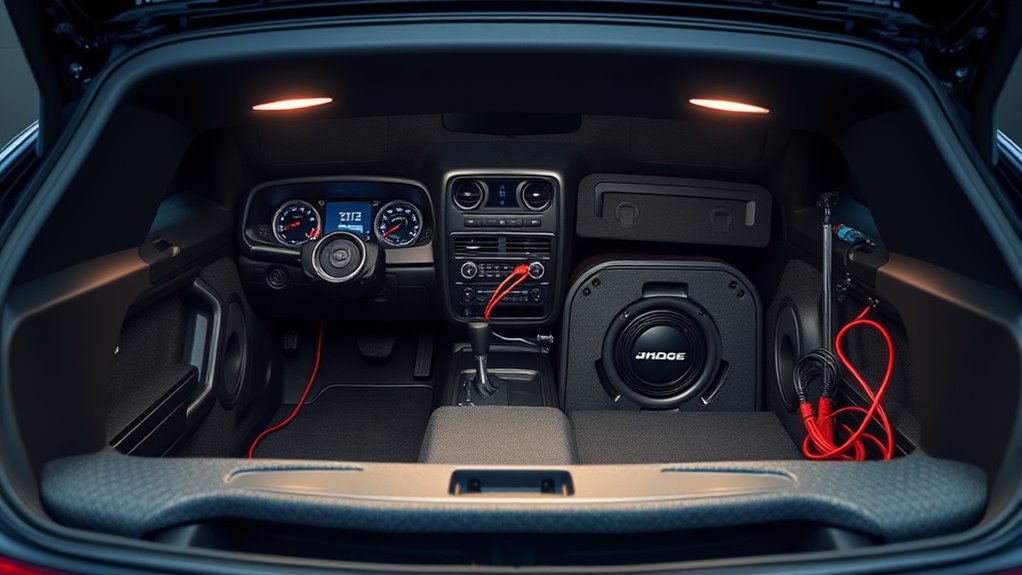
When your Dodge Charger’s front speakers suddenly go silent, pinpointing the problem requires systematic troubleshooting. First, check the speaker feed (+) and return (-) circuits at the wire harness connector for continuity and grounding issues. Make sure all fuses related to the sound system are intact, as blown fuses can cause total silence. Verify your fader settings to ensure audio isn’t just directed away from the front speakers. Disconnect the negative terminal of the battery for about 20 minutes to reset the system—this can resolve minor electronic glitches. If the problem persists, inspect wiring connections for corrosion, loose pins, or damage. Remember, speaker failure is rare; focus first on wiring, fuses, and amplifier signals before considering replacing speakers.
Frequently Asked Questions
How Do I Maintain Factory Features While Upgrading My Charger’S Sound System?
To keep your factory features intact while upgrading your Charger’s sound system, avoid replacing the head unit or dashboard screen. Use vehicle-specific wiring harnesses and integration modules to connect new components seamlessly. Install high-quality aftermarket speakers with matching impedance, add external amplifiers, and use digital sound processors for tuning. This way, you preserve factory controls, appearance, and functionality, ensuring your upgrades enhance sound without sacrificing original features.
Can I Install an Aftermarket Sound System Without Professional Help?
You might think installing an aftermarket sound system is too complex, but you can do it yourself. With factory Alpine plug-and-play adapters and common tools, you avoid splicing wires or damaging panels. Follow detailed guides and videos, and start with simple speaker replacements. While some challenges exist, patience and careful work make DIY upgrades feasible, saving you money and letting you customize your Charger’s sound to your liking.
What Are the Best Ways to Hide Aftermarket Wiring in a Dodge Charger?
To hide aftermarket wiring in your Dodge Charger, use factory wire channels along A-pillars and door seals. Route wires under dashboard panels through the glove box and fuse box area, and tuck excess wiring under seats and trim panels. Secure wires with adhesive-backed clips, use split-loom tubing for protection, and hide cables within dash cavities or behind interior trim. These techniques keep your installation clean and discreet.
How Do I Ensure Compatibility Between Aftermarket Amplifiers and Factory Systems?
Oh, so you want your shiny new amp to play nice with your factory system? First, check if your factory head unit has preamp outputs or high-level signals. Use the right interface, like PAC AmpPRO, to keep everything harmonious. Tapping into speaker wires with line output converters guarantees signal clarity. Match power levels carefully, and you’ll avoid blowing up your speakers or your reputation as a sound guru.
Are There Specific Sound Enhancements Recommended for Dodge Charger Models?
When looking to enhance your Dodge Charger’s sound, focus on upgrades that improve bass, clarity, and overall volume. Consider adding a high-quality subwoofer for deeper bass, upgrading factory speakers for better sound detail, and installing an external amplifier to power your new components effectively. Also, use signal processors or crossovers to fine-tune sound quality. Always guarantee compatibility with your model and get professional installation to maximize performance.
Conclusion
A well-installed sound system can transform your Dodge Charger into a premium audio experience. While some believe factory systems can’t be substantially improved, upgrading components and managing compatibility prove otherwise. With careful planning and the right tools, you can achieve professional-quality sound without breaking the bank. Remember, even small upgrades can make a noticeable difference—so don’t underestimate the power of a thoughtful installation to elevate your driving enjoyment.
